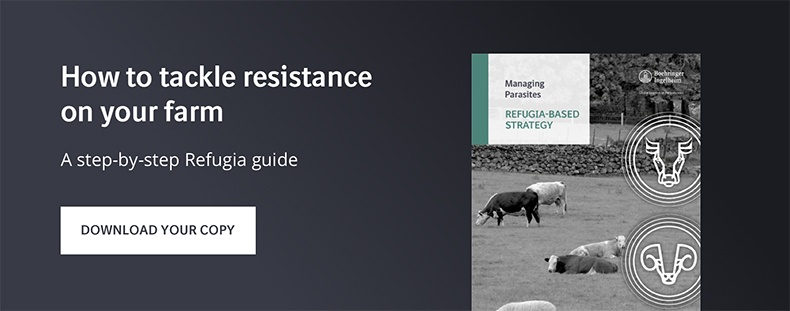Impact of parasite burdens on herd
In virtually all grazing systems, cows will be exposed to production-limiting parasites. The presence of parasites does not always result in clinical disease, but the impact of parasite burdens on herd and individual animal performance can still be substantial.
Impact gutworms have on productivity
Studies have shown the broad impact gutworms can have on productivity. Cattle carrying these parasites spend less time grazing and ingest less forage than those which are treated with anthelmintics (1). Parasites have been shown to slow growth in heifers and reduce milk yield and fertility performance in adult cows (2).
It is not realistic to completely eliminate parasites from dairy production systems where animals are grazed, but aiming to reduce parasitic load, using the most sustainable methods, can result in more productive and profitable dairy businesses.
What is the most effective way to reduce parasites
Pasture management is one of the most effective ways to reduce parasite load in cattle. In addition to this, pasture can also act as a source of refugia. This is a population of worms which are not exposed to a wormer when a treatment takes place.
In this case, it is because they are on the pasture rather than in the treated animal. When these worms re-infect animals which have been treated, they dilute any resistant worms which have survived treatment and, in doing so, maintain the genetic diversity of worms on-farm and slow the emergence of resistance. Planning Pasture worm risk is also influenced by grazing history. This should be taken into account when planning grazing.
What is low risk pasture
Low risk pasture, which was not grazed by cattle in the previous season or, later in the year, silage or hay aftermath provides a good option for first- and second-season grazing heifers, since young cattle are generally naive to parasite infection and more likely to suffer clinical disease under high parasite load. Rotating pasture regularly also allows grass to recover and regrow.
This is important since 80% of parasites are concentrated in the first 5cm of grass (3), so cattle are more likely to ingest parasites if grass is eaten down to the extreme. Strip grazing is an option if rotating whole paddocks is not feasible, but cattle should be moved on once pasture becomes bare.
When does parasite burdens increase?
The mid-summer rise in parasites which generates significant worm burdens in susceptible cattle from June onwards can be lessened by moving cattle to cleaner pasture, such as hay or silage aftermath, at this time.
To preserve anthelmintic-sensitive parasites in the population, cattle should not be wormed before moving.
If worming is deemed necessary through diagnostic testing or growth monitoring, one approach is to leave a proportion of the best performing animals untreated.
Growth monitoring
Growth monitoring can provide a useful indication of the need for targeted treatment of individuals since, if youngstock are failing to meet growth targets during the grazing season in spite of good nutrition, a worm burden is the likely cause.
Reducing stocking density is also useful for reducing parasite load in individual animals, providing sufficient grazing land is available.
Fewer animals per hectare reduces the need for cattle to graze close to dung pats, where there will be a higher proportion of infective parasite larvae.
What can have an impact on gutworm development?
Climate can have a major impact on gutworm development and survival with warm, wet weather typically resulting in an increased risk.
The position and type of water sources can also influence the challenge posed by other parasites.
How can I treat liver fluke in adult cows?
Fluke The liver fluke (Fasciola hepatica) requires an intermediate host, the mud snail, to complete its lifecycle and is found in higher numbers near to slow-moving and standing water.
Treating liver fluke in adult cows can be difficult since there are very limited anthelmintics available.
Preventing cattle from accessing natural watercourses, boggy or low-lying wet land, and restricting access to high risk pasture during winter, will help disrupt the lifecycle of the liver fluke and minimise potential infection.
Your vet or animal health adviser can provide more information about integrating grazing management techniques with appropriate anthelmintic treatments.
